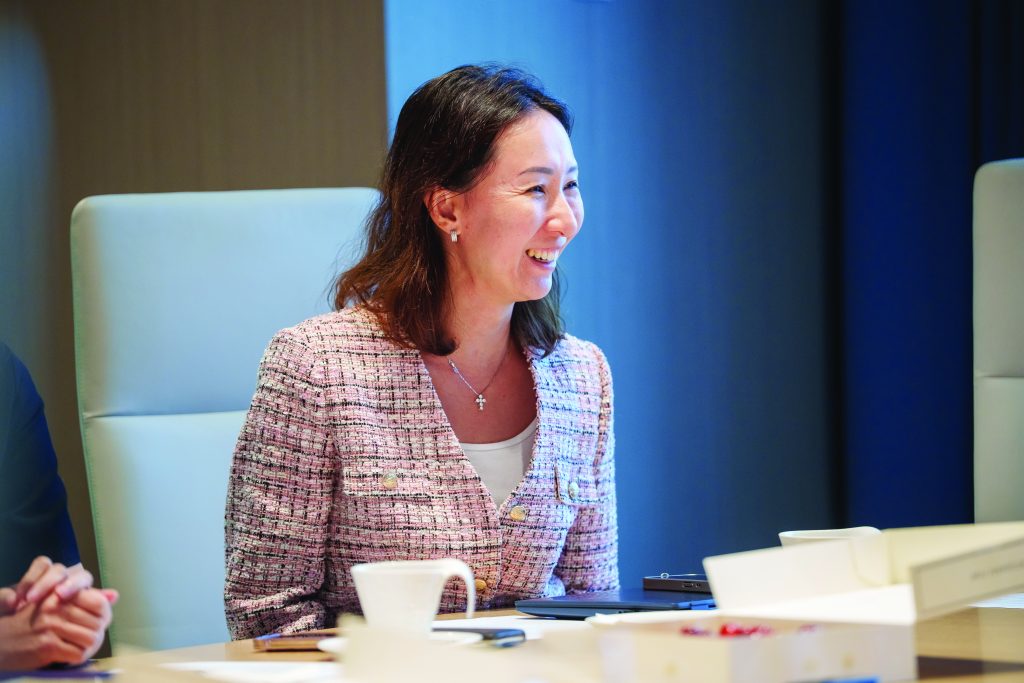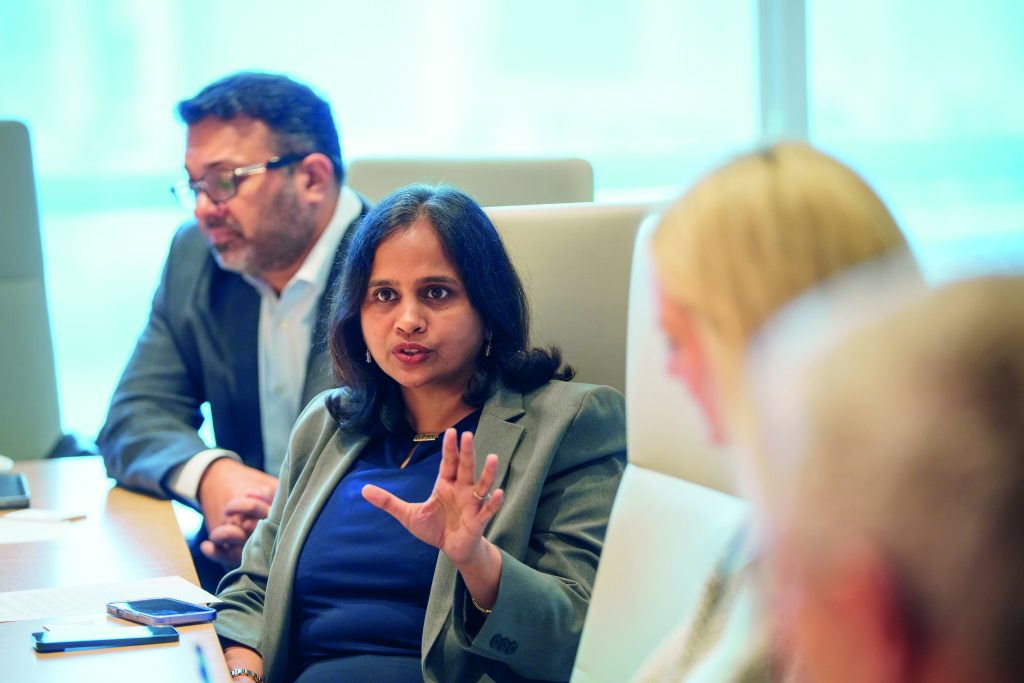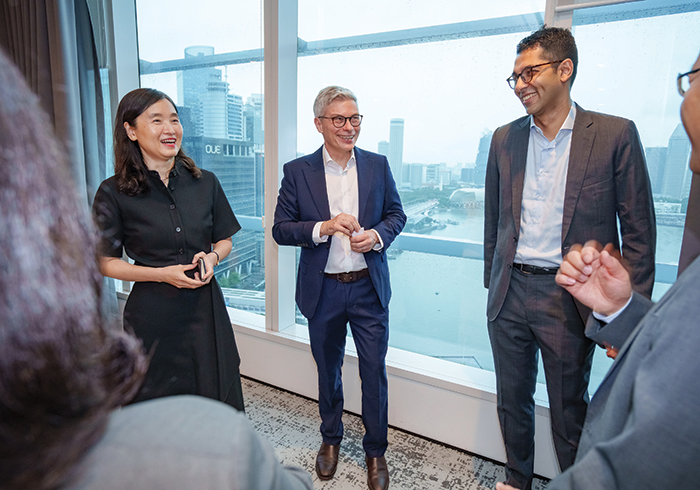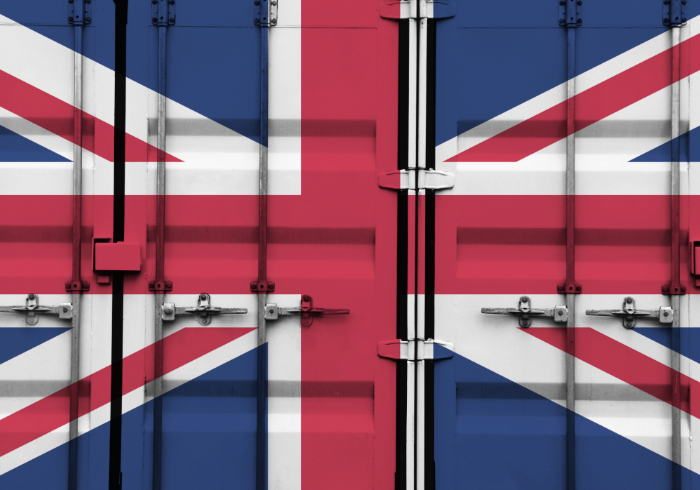Hosted in Singapore on the sidelines of GTR Asia, senior bankers weighed the real-world impact of tariffs, the durability of companies’ China-plus-one strategies and broader supply chain diversification moves, the drivers of trade finance and how far digitalisation and ESG have truly progressed in practice.
Roundtable participants:
- Runa Baksi, managing director and cluster head – Southeast Asia, Global Trade Solutions, HSBC
- Maisie Chong, managing director, global head of receivables, head of trade and working capital, Asean and South Asia, Standard Chartered
- George Fong, managing director, head of trade and supply chain finance, Asia Pacific, Bank of America
- Belinda Han, managing director, head of transaction banking, Asia Pacific, MUFG
- Shannon Manders, editorial director, GTR (chair)
- Matthew Moodey, managing director, head of trade finance and lending, Asia Pacific, Deutsche Bank
- Yoshitaka Morita, head of global trade finance department, Asia Pacific, SMBC
- Saket Sarda, managing director, Asia Pacific regional sales and structured solutions, Mizuho Bank
- Shalin Shroff, head of trade and working capital sales, Asia South, Citi
During the discussion in early September, amid revived tariff measures, tighter rules-of-origin talk and greater scrutiny of transshipment routes, participants broadly agreed that Asia’s physical and financial supply chains are undergoing a gradual reset. But rather than a clean break, the shift is happening sector by sector, with long lags and unintended consequences along the way.
Working capital efficiency has moved firmly onto the agenda of CEOs in the region, well-structured traditional trade instruments are regaining favour, and local currency solutions alongside infrastructure-linked flows are keeping financial activity within the region.
We pull together the main threads of the conversation:
Tariffs bite, but slowly
After several years of Covid-era disruption, China-plus-one diversification and stop-start tariff actions, the trade policy backdrop remains noisy, and the impact in Asia is landing unevenly and with a lag.
Citi’s Shalin Shroff set the tone: “The current tariff cycle is unlikely to stop anytime soon.” The bank’s data, he said, showed a bump in export collections in May and July as companies accelerated shipments to beat incoming US tariffs, but suggested “the real impact starts now in H2, with some estimates suggesting a near double-digit fall in US container shipping volumes”, after which “trade will need to rebalance over the coming months”.

From left to right: Shalin Shroff, Matthew Moodey, Shannon Manders, Yoshitaka Morita,
Masie Chong, Runa Baksi, Belinda Han, George Fong, Saket Sarda.
Standard Chartered’s Maisie Chong described how clients are navigating the churn: “It’s hard to keep up with what’s happening in the tariff space, because changes keep coming.” Even so, flows have not fallen off a cliff: “We’re not seeing a huge drop in volumes yet. In fact, they were front-loading in the first half of this year.” Nevertheless, the squeeze is in pricing. “We do see [the bank’s] margins coming down,” Chong said, which she linked to “a lot of competition out there”.
Deutsche Bank’s Matthew Moodey urged patience before making definitive calls on the trade outlook. “The impact is unlikely to be felt in the next six months. It’s potentially one to two years away,” he said, adding that: “Trade is fungible – like water it always finds a new home.” The experience of Brexit and China’s past restrictions on Australian imports, he noted, shows how quickly flows reroute without necessarily reducing overall trade.
Sector and country effects differ across the region. Bank of America’s George Fong said that the automotive and semiconductor sectors are facing challenges in certain markets, while other industries are leaning on domestic demand. He sees a strong regional centre of gravity: “There is definitely more reliance on intra-Asian flows, and South-South flows. We see a lot of flows going from India into the Middle East.”
“There is definitely more reliance on intra-Asia and South-South flows. We see a lot of flows going from India into the Middle East.”
George Fong, Bank of America
An intra-Asia pivot
The group agreed that Asia is trading more with itself, supported by domestic and regional investment.
MUFG’s Belinda Han quantified it: “Intra-Asia flow now accounts for around 60% of the total Asia trade flow.” That reflects diversification that began years ago and, increasingly, “a lot of infrastructure investment in the field of transportation, renewable energy, digital infrastructure and data centres”.
For Deutsche Bank’s Moodey, this is being driven by scale and self-reliance: “The internal infrastructure, power, roads, rail, everything is just massive. And so, will Asia be much more internally able to support itself than it was in the past? The answer seems to be yes.”
Against that backdrop, national strategies diverge.
In China, cost and leverage still matter. Citi’s Shroff noted that “ironically, right now, China has a lower weighted average tariff [from the US] than India”, and retains “leverage through its export of rare earths and critical minerals”, complicating hopes for simple decoupling from the country’s critical supply chains.
In India, Mizuho’s Saket Sarda reported mixed exposure to US tariffs: “Textiles, auto parts and the handicrafts market” may see “a little disruption”, whereas heavy machinery follows a different logic as India “imports technology to indigenise it… then export”.
SMBC’s Yoshitaka Morita outlined a shift in Japanese corporate focus: “We start to view India as a marketing hub, similar to China.” He also referenced a government-backed “pan-Indian Ocean” approach – manufacturing in India and exporting to the Middle East and Africa.
In Japan, Morita pointed out that the weak yen has drawn investment interest, but tariff uncertainty has already slowed some announced projects. Auto value chains, he said, turn slowly, with model cycles, tooling and supplier re-qualification making relocations a two to three-year exercise, not a quick pivot.

Working capital goes to the C-suite
The trade finance toolkit hasn’t changed, but the way banks assemble and deliver it has. “Working capital optimisation has really become the CEO scorecard,” said HSBC’s Runa Baksi. In practice, she sees corporates blending classic and structured tools. “There are solutions like inventory management,” and, where needed, “long tenure, contract monetisation” to free up capacity for selective M&A or capex.
MUFG’s Han stressed that “the underlying trade products remain unchanged: letters of credit (LCs), guarantees and supply chain finance”. The differentiator, she noted, is tailoring to support clients’ exact needs.
On the ground, Han said that means multi-country distributor finance to support Asean expansion, sustainability elements built into guarantees for renewables, and pooled receivables purchases to diversify buyer risk – plus capex-linked LCs and syndicated guarantees for large infrastructure builds. Speed of execution is also key.
“Structured trade is becoming more prominent because you have to park the risk somewhere, especially where new entities or transshipment complicate appetite.
Saket Sarda, Mizuho
Clients also want tools they can switch on quickly. Bank of America’s Fong highlighted demand for “very simple structures on usance LCs… and draft discounting” rather than heavy portfolio programmes that take months to implement.
As trade policy nudges companies into new trading routes and supplier relationships, participants agreed that risk must be looked at sensibly.
Mizuho’s Sarda noted that he sees rising demand for risk transfer and distribution. “Structured trade is becoming more prominent because you have to park the risk somewhere,” especially where new entities or transshipment complicate appetite, he said.
Sarda added that many corporates are “monetising their long-term contracts so that they still have the dry powder” for investing elsewhere, “where it could be easier”. This, in turn, is reinforcing demand for true-sale receivables, inventory-backed facilities and broader contract monetisation.
Alongside structure comes currency choice. Standard Chartered’s Chong said the funding mix is shifting toward flexibility. “While most trades remain in USD, we’ve gone full-force into cross-currency financing, booking in multiple currencies so clients can secure the best rate,” she said, adding that this will “evolve as the interest rate environment changes”.
Citi’s Shroff tied local currency growth to balance-sheet strategy, saying domestic trade is now “a very, very important” book and that, on a “fully hedged basis”, local currency financing “may come out to be lower than US dollar financing”. That, he said, means building operational deposits in growth markets.

Digital and ESG: A work in progress
After a decade of platform promises, the digital focus appears to have swung inward as banks seek to rebuild core systems, streamline processes and connect cleanly to client platforms – and then scale.
Baksi said HSBC has completed a global re-platforming with “modular, API-able, fully straight-through processing”, and launched TradePay, which “at the click of a button” can trigger vendor payments, blurring trade and cash.
Chong said Standard Chartered has put staff through data and AI training and is automating high-friction tasks such as document checks for receivables purchases, while piloting tokenisation with the Monetary Authority of Singapore.
Progress isn’t uniform. Morita at SMBC was candid about legacy complexities across the network, saying that transformation is expected to take place progressively. He added that automation is rolling out in some jurisdictions and a broader trade back-office overhaul is underway.
Participants agreed that the law still lags behind the technology. Reflecting on early blockchain efforts, Baksi cautioned: “Unless you have convergence of laws… you’re not going to really make a lot of progress,” pointing to International Chamber of Commerce work on digital standards as the likely catalyst for cross-border scale.
On ESG, the tone was pragmatic. Interest is there, especially where regulation is prompting behaviour, but incentives and labels don’t always line up.
From Mizuho, Sarda said clients are navigating mixed signals: plenty of discussion and “mandates getting closed”, yet “a green fund is not really cheaper”, and certifications are “time-consuming”. The result, he noted, is selective uptake: ESG-linked deals move ahead where requirements are clear and the effort is justified, but many remain cautious.

At Citi, Shroff said interest in ESG labelling is rising, but sustainable bond and loan issuance has declined over the past two years, and trade-related sustainable loans have moved in the same direction – even as sustainability-linked supply chain finance continues to attract attention.
At Citi, Shroff said that interest in sustainable finance solutions is evolving. Sustainable bond and loan issuance has declined over the past two years, and trade-related sustainable loans have moved in the same direction. Sustainability-linked supply chain finance, however, has seen the opposite trend, moving from entity-level ratings across a broad range of sustainability metrics to more granular decarbonisation tools, such as carbon accounting and product carbon footprints.
From SMBC, Morita highlighted the provenance problem: when solar components are sourced from China, related social concerns make sustainability-linked labelling difficult in practice.
An operational focus for 2026
While volatility has pushed clients to build resilience, regulation is forcing banks to tighten how they execute.
Deutsche Bank’s Moodey said the weight of compliance is now baked in: “Every market is becoming more complex.” Once you layer on sanctions and embargo reviews, dual-use screening and documentary requirements, it is “making trade transactions increasingly costly”, he said.
For Standard Chartered’s Chong, the priority is “driving utilisation”. “You spend a lot of time putting together these facilities, but if you’re just sitting there not using them, it really doesn’t make sense,” she said. The bank has “pivoted” its strategy toward network clients and structuring specialised solutions, while pushing simpler financing tools to SMEs to “help them get into the working capital solutions and then tying that together into the ecosystem”.
Looking to 2026, Citi’s Shroff said the operating model is evolving, with a sharper eye on efficiency and balance-sheet optimisation that has “fundamentally changed how we operate in terms of the entire originate-distribute strategy”. On client engagement, he added that staying top-of-mind as a primary partner remains critical: “In this volatile environment… [we] aim to remain amongst their first port of call.”









